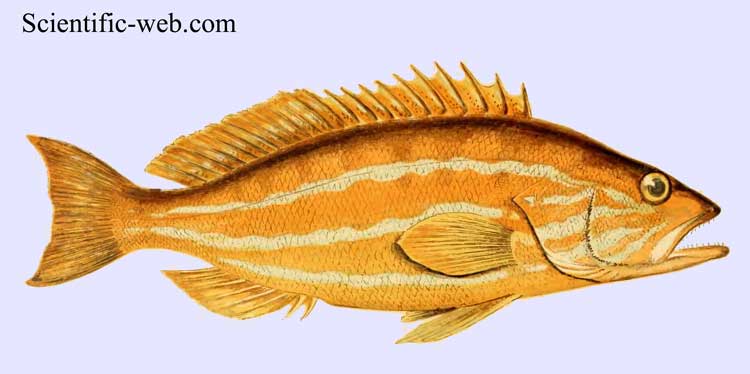
Serranus cabrilla
Superregnum: Eukaryota
Cladus: Unikonta
Cladus: Opisthokonta
Cladus: Holozoa
Regnum: Animalia
Subregnum: Eumetazoa
Cladus: Bilateria
Cladus: Nephrozoa
Superphylum: Deuterostomia
Phylum: Chordata
Subphylum: Vertebrata
Infraphylum: Gnathostomata
Megaclassis: Osteichthyes
Superclassis/Classis: Actinopterygii
Classis/Subclassis: Actinopteri
Subclassis/Infraclassis: Neopterygii
Infraclassis: Teleostei
Megacohors: Osteoglossocephalai
Supercohors: Clupeocephala
Cohors: Euteleosteomorpha
Subcohors: Neoteleostei
Infracohors: Eurypterygia
Sectio: Ctenosquamata
Subsectio: Acanthomorphata
Divisio/Superordo: Acanthopterygii
Subdivisio: Percomorphaceae
Series: Eupercaria
Ordo: Perciformes
Subordo: Percoidei
Superfamilia: Percoidea
Familia: Serranidae
Subfamilia: Serraninae
Genus: Serranus
Species: Serranus cabrilla
Name
Serranus cabrilla (Linnaeus, 1758)
Original combination: Perca cabrilla
References
Linnaeus, C. 1758. Systema Naturae per regna tria naturæ, secundum classes, ordines, genera, species, cum characteribus, differentiis, synonymis, locis, Tomus I. Editio decima, reformata. Holmiæ: impensis direct. Laurentii Salvii. i–ii, 1–824 pp DOI: 10.5962/bhl.title.542: 294. Reference page.
Serranus cabrilla in the World Register of Marine Species
Vernacular names
Afrikaans: Kammer
brezhoneg: Roue
català: Serrà
Deutsch: Sägebarsch
English: Comber
español: Cabrilla
euskara: Kraba arrunt
suomi: Pastellimeriahven
français: Serran commun
hrvatski: Kanjac
italiano: Perchia, Sciarrano comune
Nederlands: Schriftbaars
srpskohrvatski / српскохрватски: Kanjac
slovenščina: Kanjec
svenska: Större medelhavsabborre
українська: Ханос
中文: 九帶鮨
The comber (/ˈkɒmbər/;[3] Serranus cabrilla) is a species of marine ray-finned fish from the family Serranidae, the sea basses. It is widely distributed in the eastern North and South Atlantic Oceans and into the southwestern Indian Ocean. It is caught for food and fishmeal in some parts of its range.
Description
The comber has a relatively stout body with a large head and a prominent jaw.[4] It has two dorsal fins, the first has 11 thin spines and is joined to the second, which has 13-15 branched rays. The anal fin has 3 spines and 7-8 soft rays. The caudal fin is slightly truncate in shape.[5] The colouration of the comber varies from light brown to dark brown to an intense reddish brown. It is marked with 7 to 9 darker transverse bands along its flanks, these are broken by a longitudinal white to yellowish stripe, running from the head to the tail.[6] There are a few yellow or orange longitudinal lines on the sides of the head.[5] The first dorsal fin is normally folded flat against the back when the fish is in the water.[7] The comber can reach a standard length of 40 centimetres (16 in) but 25 centimetres (9.8 in) fish are more common.[2]
Distribution
The comber has an extensive distribution in the eastern Atlantic where it is found in the warmer waters in the south and southwest of England and off western Wales,[7] south along the European coast, to the Straits of Gibraltar and into the Mediterranean and Black Seas. It also occur along the west coast of Africa from Morocco southwards to Angola. Combers are found around the islands of Macaronesia and São Tomé and Príncipe in the Gulf of Guinea.[1] It also occurs off the coasts of South Africa where it is found from the Cape of Good Hope to KwaZulu-Natal.[2] Records from the Red Sea were thought to be a result of Anti-Lessepsian migration from the Mediterranean via the Suez Canal.[1] However, genetic analysis demonstrated that the Red Sea population must have existed before the opening of the Suez Canal.[8]
Habitat and biology
The comber occurs over the continental shelf and upper continental slope among rocks, Posidonia beds, and where there are substrates of sand and mud.[2] It can be found to depths of 450 metres (1,480 ft).[1] It is a predatory species which feeds mainly on crustaceans.[2] Off the Canary Islands the diet varied with size, the smaller fish consuming more crabs while the larger fish ate carideans.[9] Elsewhere their diet has been recorded as very varied and includes small and immature fish, annelids, squid and they have also been recorded scavenging on dead marine animals.[7]
The comber is a solitary and territorial species. They spawn between May and July, and are hermaphrodites, mature fish having both ovaries and testes. They are capable of being either male or female, and there are known to have been instances of self-fertilisation where fish have been unable to locate a partner for spawning.[4] Sexual maturity is attained when the fish reaches a length of 152 millimetres (6.0 in).[5]
Fisheries
The comber is of low commercial value, approximately 1,000 tons are landed from European waters.[7] It is eaten as well as being processed for fishmeal.[1]
References
Smith-Vaniz, W.F.; Iwamoto, T. (2015). "Serranus cabrilla". IUCN Red List of Threatened Species. 2015: e.T198551A42691899. doi:10.2305/IUCN.UK.2015-4.RLTS.T198551A42691899.en. Retrieved 20 November 2021.
Froese, Rainer; Pauly, Daniel (eds.) (2019). "Serranus cabrilla" in FishBase. December 2019 version.
Jones, Daniel (2011). Roach, Peter; Setter, Jane; Esling, John (eds.). "comber". Cambridge English Pronouncing Dictionary (18th ed.). Cambridge University Press. ISBN 978-0-521-15255-6.
"Cabrilla o Vaca (Serranus cabrilla)" (in Spanish). Diputación de Málaga. Retrieved 15 March 2020.
J.C. Hureau. "Comber (Serranus cabrilla)". The fishes of the NE Atlantic and Mediterranean. Marine Species Identification Portal. Retrieved 15 March 2020.
"Serranus cabrilla (Comber)". Atlantis Diving Center. 2 October 2018. Retrieved 15 March 2020.
"Comber". British Sea Fishing. Retrieved 15 March 2020.
Arthur R. Bos; Joel Ogwang; Michel Bariche; Mizuki Horoiwa; Menna Megahed; Amged Ouf; Nina Yasuda (2020). "Anti-Lessepsian migration rectified: the Comber Serranus cabrilla (L. 1758) existed in the Red Sea prior to the Suez Canal opening". Marine Biology. 167 (9): 126. doi:10.1007/s00227-020-03748-0. S2CID 225432110.
Victor M. Tuset; José A. González; M. Mercedes García-Díaz; José I. Santana (1996). "Feeding habits of Serranus cabrilla (Serranidae) in the Canary Islands". Cybium: International Journal of Ichthyology. 20 (2): 161–167.
Retrieved from "http://en.wikipedia.org/"
All text is available under the terms of the GNU Free Documentation License

